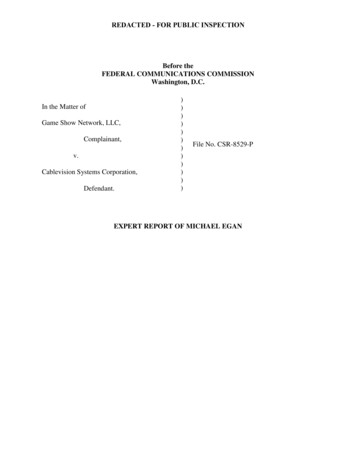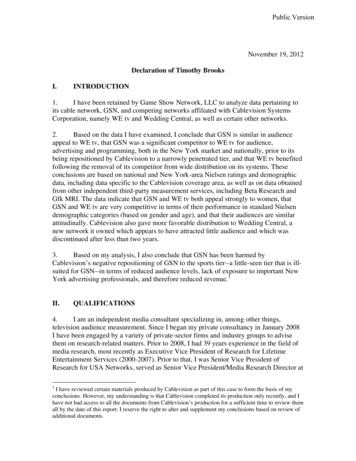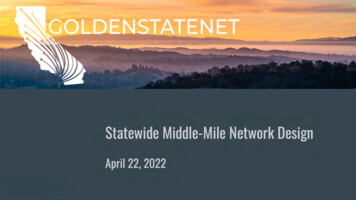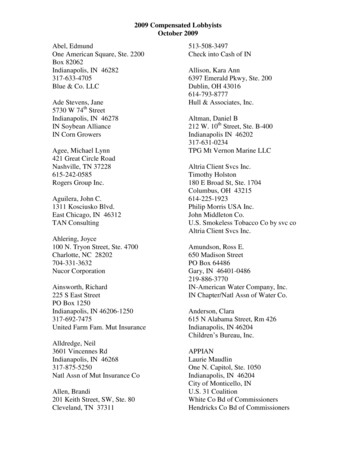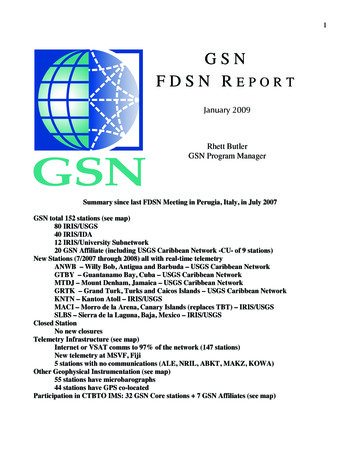
Transcription
1GSNFDSN REPORTJanuary 2009Rhett ButlerGSN Program ManagerSummary since last FDSN Meeting in Perugia, Italy, in July 2007GSN total 152 stations (see map)80 IRIS/USGS40 IRIS/IDA12 IRIS/University Subnetwork20 GSN Affiliate (including USGS Caribbean Network -CU- of 9 stations)New Stations (7/2007 through 2008) all with real-time telemetryANWB – Willy Bob, Antigua and Barbuda – USGS Caribbean NetworkGTBY – Guantanamo Bay, Cuba – USGS Caribbean NetworkMTDJ – Mount Denham, Jamaica – USGS Caribbean NetworkGRTK – Grand Turk, Turks and Caicos Islands – USGS Caribbean NetworkKNTN – Kanton Atoll – IRIS/USGSMACI – Morro de la Arena, Canary Islands (replaces TBT) – IRIS/USGSSLBS – Sierra de la Laguna, Baja, Mexico – IRIS/USGSClosed StationNo new closuresTelemetry Infrastructure (see map)Internet or VSAT comms to 97% of the network (147 stations)New telemetry at MSVF, Fiji5 stations with no communications (ALE, NRIL, ABKT, MAKZ, KOWA)Other Geophysical Instrumentation (see map)55 stations have microbarographs44 stations have GPS co-locatedParticipation in CTBTO IMS: 32 GSN Core stations 7 GSN Affiliates (see map)
2BackgroundThe Global Seismographic Network (GSN), managed by the Incorporated Research Institutions forSeismology (IRIS) in collaboration with the US Geological Survey, is a fundamental internationalsystem for seismic monitoring, research, and educational training. The entire network of 130 corestations transmits data in real-time to the US, where the data are openly available to all government,public, private researchers, and the international community.Initiated in 1986 by the US scientific community, the GSN is a multi-use, multi-agency scientificresource essential to the achievement of many missions. The GSN: serves as key, first-warning element in US and international tsunami warning systems; provides core data for global earthquake monitoring, rapid hazard assessment and promptresponse to natural disasters; is a cornerstone scientific facility for the study of earthquakes and the Earth’s interior; supplies the single largest contribution (46 sites designated) to the international monitoringsystem for the Comprehensive Nuclear Test Ban Treaty (CTBT); and is crucial for the training and education of the next generation of earth scientists.Network & Station OperatorsASLUSGS Albuquerque Seismological LaboratoryIDAUniversity of California, San Diego SIO/IGPP IDA ProjectInstallationsThe map shows the current GSN station (red stars), planned sites (red-white stars) for completion, andthe affiliate arrays (orange stars). FDSN Backbone Network stations are also shown (purple). ManyGSN stations are cooperative with other networks, indicated by the symbol on the ‘shoulder’ of the starwhere our collaborators have provided equipment. Only one GSN site remains to be completed in 2009by IRIS/IDA — WAHI United Arab Emirates. A proposed site on the West Antarctic Ice Sheet is beinginvestigated.The GSN continues to support the inclusion of additional sensors at GSN sites as part its GeophysicalObservatory program. Recent installations include microbarographs on KNTN, Kanton Atoll and SLBS,Baja California, Mexico.
3TelecommunicationsThe GSN uses a wide variety of telemetry systems coordinated with many organizations and hosts,illustrated in the GSN telemetry map. Eight new telemetry links have been implemented from 7/20072008, including new VSATs installed at the 7 new GSN sites. The Geophysical Survey of the RussianAcademy of Sciences recently made provision for telemetry for 6 GSN sites in the Russian Far East.Cooperation with the Comprehensive Nuclear Test Ban Treaty Organization (CTBTO) in sharing theirGlobal Communication Infrastructure system is an important component of GSN telemetry. CTBTOVSATs are now being used as the primary or backup links for GSN telemetry at 24 locations. Ten GSNstations in the Pacific Ocean are telemetered directly to the Pacific Tsunami Warning Center. Over 1TByte/yr of GSN data are used by Tsunami Warning Centers internationally.New InstrumentationNext Generation Data Acquisition Systems (NGS). Systems integration of the NGS, based on theQuanterra Q330HR, has been completed by the USGS Albuquerque Seismological Laboratory and theUCSD IRIS/IDA group. Since July 2007, 14 NGS have been deployed in the GSN (see map).Antarctic Remote Autonomous Station Design. GSN has received NSF Office of Polar Programs funding(in collaboration with IRIS PASSCAL and UNAVCO) to develop the basic power and communicationsinfrastructure needed to run remote observatories in the polar environments year-round through the polarwinter. Developments arising from this grant will be utilized for installing autonomous stations in bothAntarctica and Greenland. In particular, progress has been made in powering systems in Antarcticathroughout the polar year, using a combination of solar panels and lithium batteries. Designed and testedenvironment enclosures incorporate R50 vacuum panels with ancillary foam packing and specializedcable routing to minimize heat leakage, intended to maximize heat retention of the low poweracquisition and power control systems. Lightweight structural elements for solar panels with fold-downdesign have been tested for transport in light-aircraft/helicopter and easy deployment to minimize timeon the ground. All components can be handled in extreme cold with heavy gloves. A power controlsystem provides automatic switching between primary lithium thionyl chloride battery packs andphotovoltaic system to assure continuous system operations in transition from day to night. Lithiumbattery packs may be scaled specifically to the power model of particular equipment deployed.
4In application to semi-permanent deployments in Greenland, the seismic system field package isexpected to weigh 250 kg for surface installations, plus additional weight for borehole seismic gear.Nominal power requirements are: 3ch seismic site (Q330 Guralp3T 1 watt), with options for telemetrysystems based on the proximity of existing infrastructure (Iridium 5 watt, cell modem 1 watt, radio link1.5 watt).The first 20 instruments were deployed by PASSCAL during the 2007-2008 Austral Summer as part ofInternational Polar Year (IPY) efforts of the NSF in the Antarctic, and were recently serviced during thecurrent 08-09 Austral summer season. Preliminary results show a 88% data return which iscomparable to standard PASSCAL deployments. Temperatures in the high Antarctic Plateau weretypically -75C with 6 months with no sun. Designs information may be found athttp://www.passcal.nmt.edu/Polar/Design/.
GLOBAL SEISMOGRAPHIC NETWORK& INTERNATIONAL FEDERATION OF DIGITAL SEISMOGRAPHIC NETWORKSKBS ALE1/2009 KEV BILLSFJDCOLA A NRILTIXI BORG KONO ILAR MA2ARU LVZ OBN YAK ATLYFFCESK YSSHIA KIV KURKMAKZKDAK RSSDMDJ A PET ATTU COR KIEV BRVKAAK BFOULNADK WCIPAB WMQ BJT ERMNVAR GRFO CCM HRV CMLAsμ CMB PDAR SSPA LSA XAN ANTO MAJO AANMO GNI ABKTPASWVT NILMIDW INCN BBSRKMIPFO KBL SSETUC HKT DWPF GRTK MACI H2O KIP WAKETXAR GTBYENH WAHI SDDR TATO ANWBKOWARAYN SLBS BBGH QIZ GUMO KWAJTEIGMTDJ SJG JOHN POHA FURI TGUHCHTO GRGR SACV JTS DAVPALK BCIP SDV TARA KNTN XMAS PTGAMBAR MSEYBTDFASCN PAYG FUNAHNR KAPIOTAV MSKU LSZ KMBO DGAR PMG MSVF RCBR ABPONNAWRABCOCO AFISAML SHELMBWA PTCN RPNTSUM LVCCTAORAOLBTB RAR TRIS LCO NWAOSURSNZO TRQA TAU EFI HOPE A PMSA 7/2007–12/2008IRIS AffiliateCurrent Array Geoscope Japan Mednet QSPA CASY WANT SBAVNDAA IRIS International & National Cooperative SitesSpainGeofon/AWI/BGR/BFO China/USGS Mexico Singapore Botswana MCQ Australia in 2009USGS AFTACA SMUsµ
GSN COMMUNICATIONS 1/2009 7/2007–12/2008 IRIS/NSF NWS USGS China Australia Russia AFTAC/DoD CTBTO GSN HostVSATInternet Delayedor blocked Data shipped via mail
GSN & GEOPHYSICAL OBSERVATORIES Co-located sensor GSN sensor Gravimeter GPS Barograph Magnetometer Meteorological 1/2009
GLOBAL SEISMOGRAPHIC NETWORK& INTERNATIONAL MONITORING SYSTEM (IMS) 1/2009 GSN IMS Designated Stations GSN IMS Stations Other IMS Seismic Stations
the affiliate arrays (orange stars). FDSN Backbone Network stations are also shown (purple). Many GSN stations are cooperative with other networks, indicated by the symbol on the 'shoulder' of the star where our collaborators have provided equipment. Only one GSN site remains to be completed in 2009 by IRIS/IDA — WAHI United Arab Emirates.

